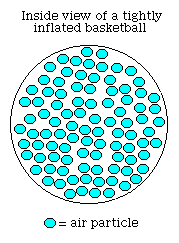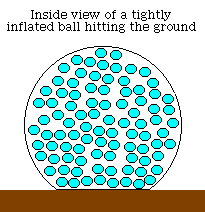
What is the physics behind bouncing a basketball?
Energy can neither be created nor destroyed, but it can be transferred from one from to another and from one object to another.
When a basketball is lifted off the ground energy is transferred to it in the form of potential energy (U)
U = mgh , m = mass, g = gravity, h = height
When a basketball is released from some height h, energy is transferred from potential energy into kinetic energy (KE), the energy of motion.
KE = 1/2 mv2, m = mass, v = velocity
When a basketball hits the ground an elastic collision takes place. In a perfectly elastic collision 100% of the total kinetic energy of the system is conserved. The collision between a basketball and the ground is about 80% elastic so 80% of the kinetic energy is conserved. The other 20% is consumed by thermal energy, which comes from internal frictional forces in the ball and the ground. The KE from the rebound is then transferred to U as the ball bounces from the floor to some height. When the basketball rebounds off the ground it does not return to its original height because of the energy loss due to friction.

What happens to a basketball when it hits the floor?
For every action there is an equal and opposite reaction.
The air pressure inside a basketball greatly affects the elasticity of the ball and conservation of energy of the ball. Air is a gas and gases are in constant motion colliding with each other and the walls inside the fixed volume of the ball. When a basketball is dribbled it hits the floor and the force of the floor hitting back on the basketball causes the basketball to indent. When this happens the volume of the ball is compressed causing all of the air particles in the ball to become more tightly packed, which causes the air particles to collide at much greater speeds. This causes the ball to inflate back to its original volume and rebound off of the floor into the air. During this collision some of the kinetic energy is lost and is transferred into thermal energy causing the ball to not bounce back to its original height.
When there is not much air pressure in the basketball the air particles collide at a much slower speed than a basketball with greater air pressure. In conclusion basketballs bounce better with greater air pressure because of the speed of air particle collisions.

